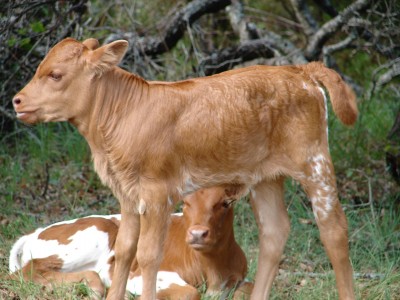A table for two (calves) by Abby Bauer
Alycia Drwencke, Dairy Management Specialist
Southwest New York Dairy, Livestock and Field Crops Program

BY ABBY BAUER, ASSOCIATE EDITOR
Through research and practical experience, we continue to learn more about the benefits of social housing for young dairy calves. There's proof that social contact is desirable from the calf's perspective, too.
In the July Hoard's Dairyman webinar, Emily Miller-Cushon, an associate professor at the University of Florida, talked about calves and group housing. She said research has shown that individually housed calves will work to achieve access to a social companion, and that grouped calves will chose to spend more time with familiar social companions.
This is true even when calves are eating. In a study by Miller-Cushon, half the calves were housed individually prior to weaning, while the other group was housed in pairs. After weaning, all calves were put into pairs.
Two weeks later, a barrier was placed in the pen to create two feeding stations. A calf could either choose to eat from a bucket next to its pen mate or it could eat alone. In the next phase of the study, the second bucket was removed. The calf could eat with its buddy from the same bucket or eat alone from its own bucket. Interestingly, well over half of the time, the calf chose to eat with its friend — even if it had to share the bucket.
The calves that were previously housed individually chose to eat with a partner about 60% of the time; for the calves housed in pairs from the start, it was over 75% of the time. Miller-Cushon noted that these responses make sense given the social bonds calves form, and it might suggest that the preference for social feeding may be greater in calves that are raised socially.
That being said, feeding in group situations has pros and cons. "The effect of social contact on feeding behavior is a real benefit of social housing, but it does provide some issues that have to be effectively managed," Miller-Cushon explained.
She said that social contact early in life raises calves' willingness to eat novel feed and stimulates solid feed intake overall. The sight of another calf eating may encourage a resting calf to get up and eat as well. This desire to eat together can also be a hinderance, though.
"Because calves want to eat together, competition can be a problem," she said. "We see that when we start to restrict feeding spaces per calves." She explained that expanding the number of calves per feeder can cause faster rate of intake, longer wait times for access to the feeder, and more frequent displacements or disturbances at the feeder.
Miller-Cushon said that despite these behaviors that result due to competition at the feeder or feedbunk, we are finding that calves still try to eat together. This can lead to reduced milk intake and supports the need for more nipples per pen or fewer calves per feeder.
To learn more about calf rearing and Miller-Cushon's research, watch the archived webinar "Calf management, behavior, and welfare" on our website. This webinar was sponsored by Agri-Plastics.
Upcoming Events
Crops, Cows & Critters - Southwest New York Dairy, Livestock & Field Crops Newsletter Sponsorship
December 19, 2025
Our two forms of publications feature research-based and timely information from our four specialists, listed to the right, along with local event notifications and Cornell University outreach. This information is provided to participants who range from dairy, livestock, and field crops producers to agricultural suppliers and consultants.
Weekly Email Update: Shared with 625+ households who have signed up with our program.
Monthly Paper Mailer: To reach our stakeholders and farmers who lack internet access, we send out a monthly mailer where your company's logo and contact information would be featured with a mailing list of 330+ households.
If you sponsor our weekly and monthly publications you reach approximately 955 households.
Visit our website to view our newsletters!
2025 Cornell Food Beverage & Animal Feed Manufacturer Survey
December 19, 2025
Industry and Educational Advocates for New York State's Food, Beverage, and Animal Feed Manufacturing industries:
As you know, NYS has a diverse food and beverage manufacturing industry, in both the types of industries that exist and the wide distribution of firms by scale. Many manufacturing firms have strong backward linkages to agricultural production sectors in the state that support both farm-level and downstream food industry firms and consumers. In collaboration with the New York State Department of Agriculture and Markets, a team from Cornell University's Charles H. Dyson School of Applied Economics and Management has recently rolled out the 2025 New York State Food, Beverage, and Animal Feed Manufacturer Survey. The industry will benefit from an updated assessment of the industry that informs private and public investments and opportunities to support firm growth and improved profitability.
Cornell Organic Field Crops & Dairy Conference
March 6, 2026
Waterloo, NY
Farmers, researchers, educators, and agricultural service providers from across the Northeast are invited to the 2026 Cornell Organic Field Crops & Dairy Conference, held Friday, March 6, 2026, from 8:00 a.m. to 4:30 p.m. at the Lux Hotel & Conference Center in Waterloo, N.Y.
Co-hosted by New York Soil Health and Cornell CALS, the annual conference brings together leaders in organic grain, dairy, and livestock systems to share practical tools, new research, and farmer-tested strategies to support resilient and profitable organic production.
Announcements
No announcements at this time.





